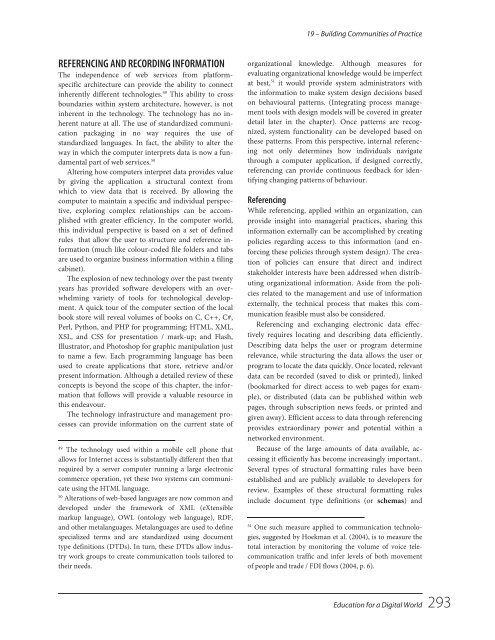Education for a Digital World Advice, Guidelines and Effective Practice from Around Globe, 2008a
Education for a Digital World Advice, Guidelines and Effective Practice from Around Globe, 2008a
Education for a Digital World Advice, Guidelines and Effective Practice from Around Globe, 2008a
Create successful ePaper yourself
Turn your PDF publications into a flip-book with our unique Google optimized e-Paper software.
19 – Building Communities of <strong>Practice</strong><br />
REFERENCING AND RECORDING INFORMATION<br />
The independence of web services <strong>from</strong> plat<strong>for</strong>mspecific<br />
architecture can provide the ability to connect<br />
inherently different technologies. 49 This ability to cross<br />
boundaries within system architecture, however, is not<br />
inherent in the technology. The technology has no inherent<br />
nature at all. The use of st<strong>and</strong>ardized communication<br />
packaging in no way requires the use of<br />
st<strong>and</strong>ardized languages. In fact, the ability to alter the<br />
way in which the computer interprets data is now a fundamental<br />
part of web services. 50<br />
Altering how computers interpret data provides value<br />
by giving the application a structural context <strong>from</strong><br />
which to view data that is received. By allowing the<br />
computer to maintain a specific <strong>and</strong> individual perspective,<br />
exploring complex relationships can be accomplished<br />
with greater efficiency. In the computer world,<br />
this individual perspective is based on a set of defined<br />
rules that allow the user to structure <strong>and</strong> reference in<strong>for</strong>mation<br />
(much like colour-coded file folders <strong>and</strong> tabs<br />
are used to organize business in<strong>for</strong>mation within a filing<br />
cabinet).<br />
The explosion of new technology over the past twenty<br />
years has provided software developers with an overwhelming<br />
variety of tools <strong>for</strong> technological development.<br />
A quick tour of the computer section of the local<br />
book store will reveal volumes of books on C, C++, C#,<br />
Perl, Python, <strong>and</strong> PHP <strong>for</strong> programming; HTML, XML,<br />
XSL, <strong>and</strong> CSS <strong>for</strong> presentation / mark-up; <strong>and</strong> Flash,<br />
Illustrator, <strong>and</strong> Photoshop <strong>for</strong> graphic manipulation just<br />
to name a few. Each programming language has been<br />
used to create applications that store, retrieve <strong>and</strong>/or<br />
present in<strong>for</strong>mation. Although a detailed review of these<br />
concepts is beyond the scope of this chapter, the in<strong>for</strong>mation<br />
that follows will provide a valuable resource in<br />
this endeavour.<br />
The technology infrastructure <strong>and</strong> management processes<br />
can provide in<strong>for</strong>mation on the current state of<br />
49<br />
The technology used within a mobile cell phone that<br />
allows <strong>for</strong> Internet access is substantially different then that<br />
required by a server computer running a large electronic<br />
commerce operation, yet these two systems can communicate<br />
using the HTML language.<br />
50<br />
Alterations of web-based languages are now common <strong>and</strong><br />
developed under the framework of XML (eXtensible<br />
markup language), OWL (ontology web language), RDF,<br />
<strong>and</strong> other metalanguages. Metalanguages are used to define<br />
specialized terms <strong>and</strong> are st<strong>and</strong>ardized using document<br />
type definitions (DTDs). In turn, these DTDs allow industry<br />
work groups to create communication tools tailored to<br />
their needs.<br />
organizational knowledge. Although measures <strong>for</strong><br />
evaluating organizational knowledge would be imperfect<br />
at best, 51 it would provide system administrators with<br />
the in<strong>for</strong>mation to make system design decisions based<br />
on behavioural patterns. (Integrating process management<br />
tools with design models will be covered in greater<br />
detail later in the chapter). Once patterns are recognized,<br />
system functionality can be developed based on<br />
these patterns. From this perspective, internal referencing<br />
not only determines how individuals navigate<br />
through a computer application, if designed correctly,<br />
referencing can provide continuous feedback <strong>for</strong> identifying<br />
changing patterns of behaviour.<br />
Referencing<br />
While referencing, applied within an organization, can<br />
provide insight into managerial practices, sharing this<br />
in<strong>for</strong>mation externally can be accomplished by creating<br />
policies regarding access to this in<strong>for</strong>mation (<strong>and</strong> en<strong>for</strong>cing<br />
these policies through system design). The creation<br />
of policies can ensure that direct <strong>and</strong> indirect<br />
stakeholder interests have been addressed when distributing<br />
organizational in<strong>for</strong>mation. Aside <strong>from</strong> the policies<br />
related to the management <strong>and</strong> use of in<strong>for</strong>mation<br />
externally, the technical process that makes this communication<br />
feasible must also be considered.<br />
Referencing <strong>and</strong> exchanging electronic data effectively<br />
requires locating <strong>and</strong> describing data efficiently.<br />
Describing data helps the user or program determine<br />
relevance, while structuring the data allows the user or<br />
program to locate the data quickly. Once located, relevant<br />
data can be recorded (saved to disk or printed), linked<br />
(bookmarked <strong>for</strong> direct access to web pages <strong>for</strong> example),<br />
or distributed (data can be published within web<br />
pages, through subscription news feeds, or printed <strong>and</strong><br />
given away). Efficient access to data through referencing<br />
provides extraordinary power <strong>and</strong> potential within a<br />
networked environment.<br />
Because of the large amounts of data available, accessing<br />
it efficiently has become increasingly important..<br />
Several types of structural <strong>for</strong>matting rules have been<br />
established <strong>and</strong> are publicly available to developers <strong>for</strong><br />
review. Examples of these structural <strong>for</strong>matting rules<br />
include document type definitions (or schemas) <strong>and</strong><br />
51<br />
One such measure applied to communication technologies,<br />
suggested by Hoekman et al. (2004), is to measure the<br />
total interaction by monitoring the volume of voice telecommunication<br />
traffic <strong>and</strong> infer levels of both movement<br />
of people <strong>and</strong> trade / FDI flows (2004, p. 6).<br />
<strong>Education</strong> <strong>for</strong> a <strong>Digital</strong> <strong>World</strong> 293


















